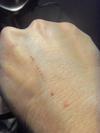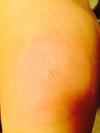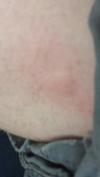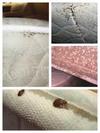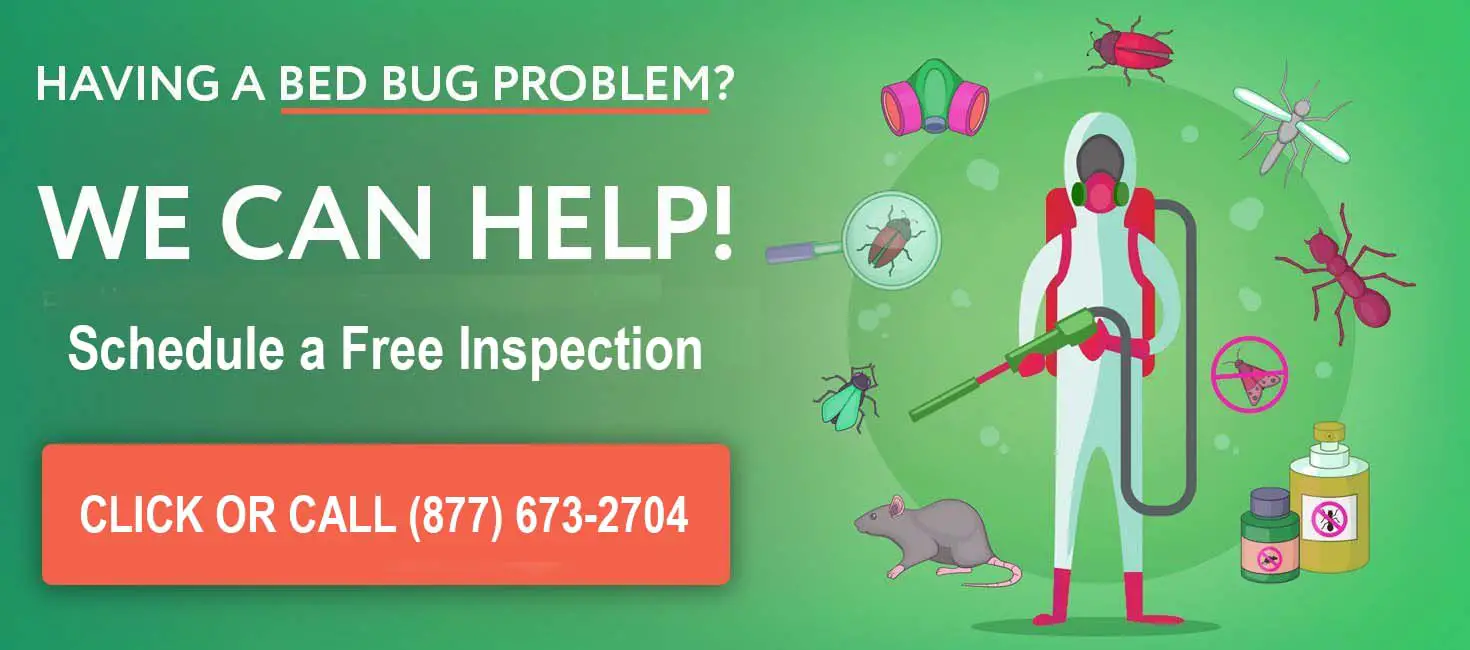Bed bugs are small, reddish-brown, parasitic insects about the size of an apple seed that feed on human blood, typically during the night. Their bites often appear on exposed areas such as the neck, shoulders, arms, and lower legs. Reactions vary significantly: some individuals experience no symptoms, while others develop small red welts, swelling, or even blisters. These reactions can manifest within 30 minutes or be delayed by several days. Notably, bed bugs are not known to spread disease, making their bites more of an uncomfortable nuisance than a health threat. Observing their feeding behavior can help in identifying the source of the bites.
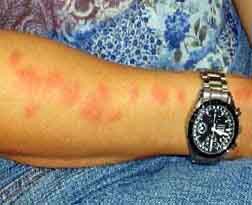 Bed Bug Bite Straight Line Pattern on Arm
Bed Bug Bite Straight Line Pattern on Arm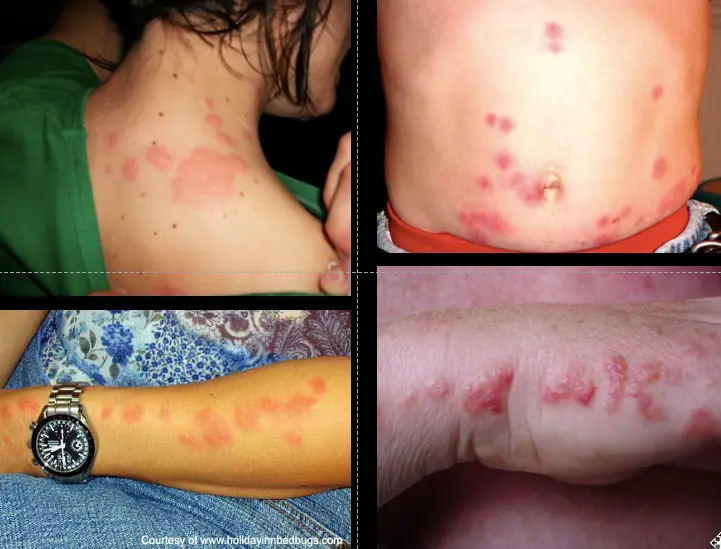 Bed Bug Bite Symptoms on Back, Stomach, Arm and Leg
Bed Bug Bite Symptoms on Back, Stomach, Arm and LegIdentifying Bed Bug Bites
Identifying bed bug bites can be challenging, as they often resemble bites from other insects like mosquitoes, flea bites, or most spider bites. However, bed bug bites may present distinct patterns, such as multiple bites in a line, zigzag pattern, or cluster, especially if the affected area was in contact with a mattress seam or upholstered furniture where bed bugs hide.
Bites frequently occur in lines or clusters on one part of the body. Some people experience large, itchy welts, while others may have smaller, red dots. Additional signs include the presence of the insects themselves, rusty-colored blood spots, bedbug excrement, or dark red stains on bed sheets or nearby furniture. Bed bugs may also leave behind oval eggs, shed skins, recently fed insects, adult bed bugs, young bed bugs, or a sweet musty odor. Comparing bed bug bites to other insect bites can help in identifying the source. Bite marks often appear in clusters or lines, helping differentiate bed bug bites from other insect bites.
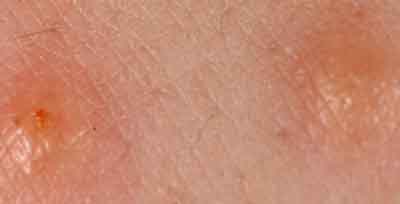 Bed Bug Bites on Arm
Bed Bug Bites on ArmSymptoms and Reactions
While many people may not react to bed bug bites, others can experience allergic reactions ranging from mild itching to severe anaphylaxis. Reactions to bites differ significantly among individuals; some people have severe itching and swelling, while others may not react at all. Excessive scratching can lead to secondary infections such as impetigo, folliculitis, cellulitis, or other skin infections. If you develop symptoms like hives, trouble breathing, or swelling of the throat or mouth after being bitten, seek emergency medical attention immediately. Some bites may develop a dark red center, and reactions may vary depending on several factors, including individual sensitivity and the frequency of bites. Severe allergic reactions are rare but possible.
Close up Pictures of Bed Bug Bites
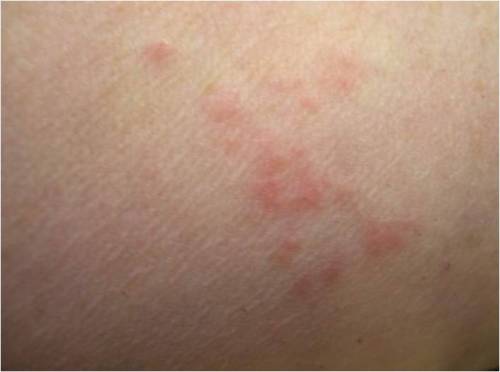 Picture Bed Bugs Bite Skin Reaction
Picture Bed Bugs Bite Skin ReactionThis is the Typical Skin Reaction That Occurs Immediately After Being Bitten
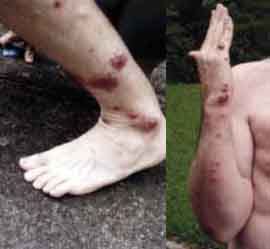 Bullous Bed Bug Bite Eruptions on Hand and Leg
Bullous Bed Bug Bite Eruptions on Hand and Leg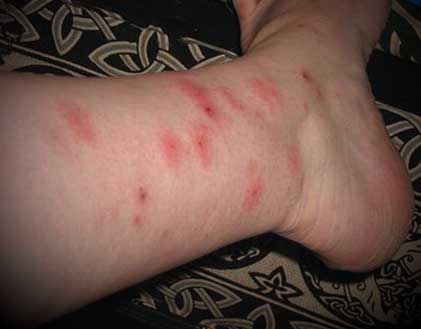 Bed Bug Bites on Lower Leg
Bed Bug Bites on Lower Leg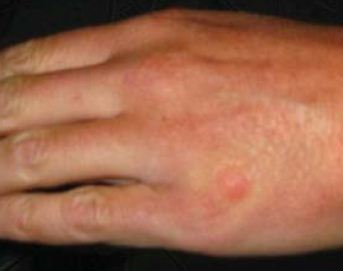 Bed Bug Bite on Hand
Bed Bug Bite on HandTriangle Bite Marks and Patterns
Some individuals report observing "3 bites in a triangle," or similar patterns. While this pattern is sometimes attributed to bed bugs, it is not a definitive indicator of their presence. Other insects, such as spiders, can also cause bite patterns resembling a triangle. Careful inspection of the affected area and surroundings for additional signs, like rusty stains or bedbug excrement, is necessary to confirm whether bed bugs are responsible.
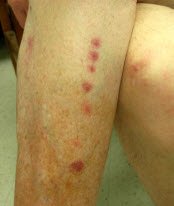 Bed But Bite Line Pattern Probably Caused by Bed Bugs Hiding Along a Seam Where the Arm Rested When Sleeping
Bed But Bite Line Pattern Probably Caused by Bed Bugs Hiding Along a Seam Where the Arm Rested When Sleeping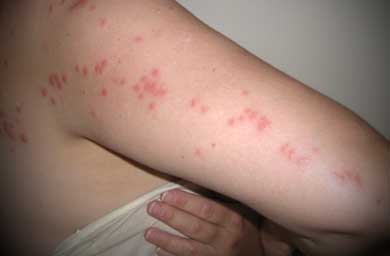 Bites In A Line Usually Occur Along A Blood Vessel Near the Skin Surface
Bites In A Line Usually Occur Along A Blood Vessel Near the Skin Surface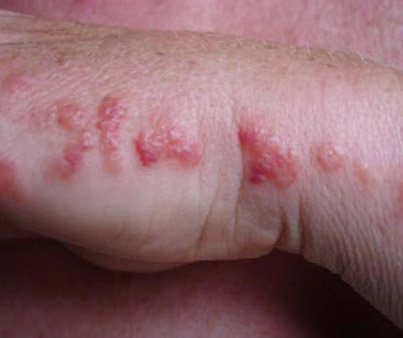 Bed Bug Bite Marks on Arm
Bed Bug Bite Marks on Arm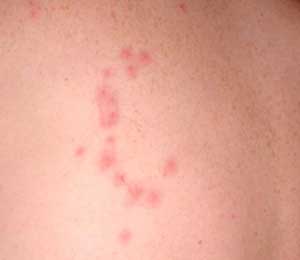 Bed Bug Bites In a Circle Pattern On Back
Bed Bug Bites In a Circle Pattern On Back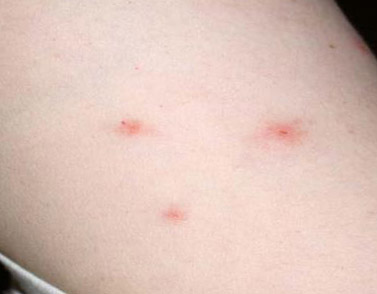 Bed Bug Bites in a Triangle Pattern
Bed Bug Bites in a Triangle Pattern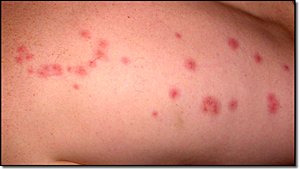 Bed Bug Bites in a Circle Pattern on Arm
Bed Bug Bites in a Circle Pattern on ArmChronic Skin Reactions
Highly allergic people or if you have bites on more than one occasion, you could see a more chronic or severe skin reaction.
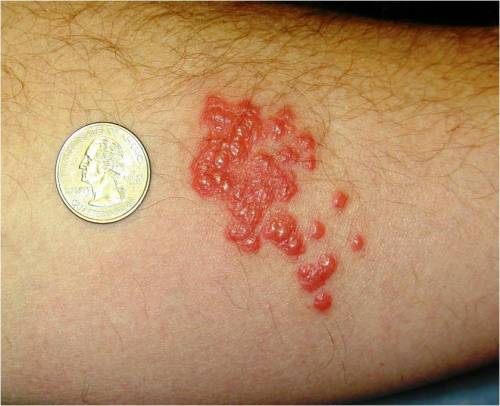 Up Close Photo of a BedBugs Bite Skin Reaction
Up Close Photo of a BedBugs Bite Skin Reaction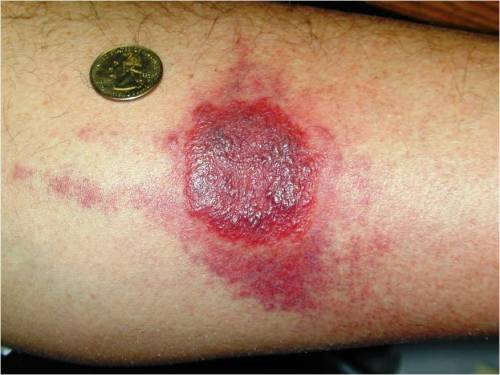 Single Bed Bug Bite Wheal Skin Reaction
Single Bed Bug Bite Wheal Skin Reaction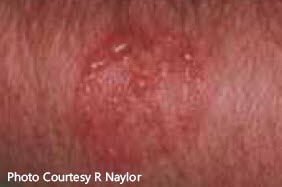 Bed Bug Bite Skin Rash
Bed Bug Bite Skin Rash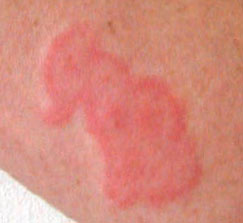 Bed Bug Rash on Arm
Bed Bug Rash on Arm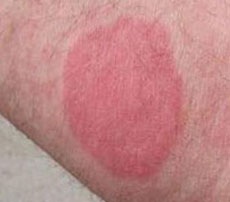 Bed Bug Wheal Reaction
Bed Bug Wheal Reaction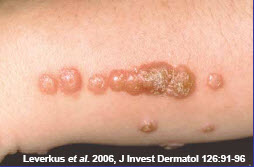 Bed Bug Bite Skin Blister Reaction
Bed Bug Bite Skin Blister Reaction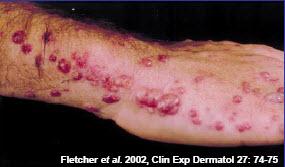 Bed Bug Bite Blisters on Arm - Hypersensitive Reaction
Bed Bug Bite Blisters on Arm - Hypersensitive ReactionUncommon Bite Locations
Most bed bugs hide in or around the bed, particularly in bed seams and under any bed labels. When the host is sleeping, they will move to the nearest exposed skin area on the body, such as the legs, arms and neck, and then bite the host. Among those that do have an allergic reaction to the bed bug bite, there can be a single bite or many in an area, depending on the size of the infestation. When bites are found in a row on the skin, it is probably due to a leg leaning against a bed seam, where several bed bugs are hiding.
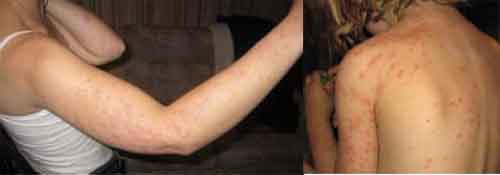 Hundreds of Bed Bug Bites on Back and Arm
Hundreds of Bed Bug Bites on Back and Arm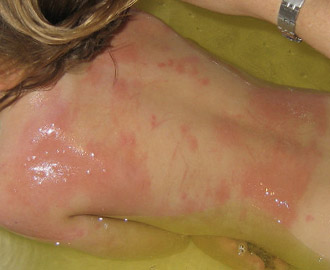 Erythema Skin Reaction from Scratching Bed Bug Bites
Erythema Skin Reaction from Scratching Bed Bug Bites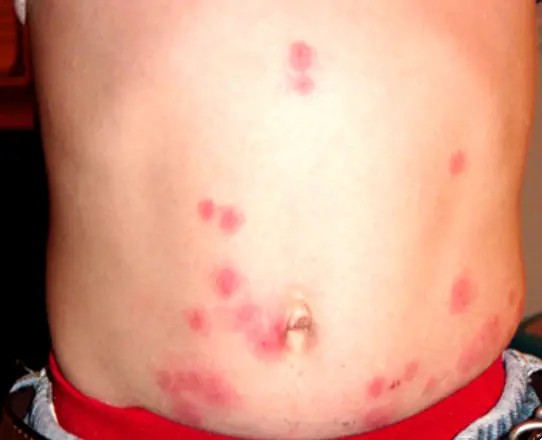 Bed bug bites on stomach. Bites are 2mm to 5mm in size and are referred to as erythematous (redness of the skin or mucous membranes due to the accumulation of blood in dilated capillaries) or maculopapular (flat, reddened area of skin present in a rash) lesions.
Bed bug bites on stomach. Bites are 2mm to 5mm in size and are referred to as erythematous (redness of the skin or mucous membranes due to the accumulation of blood in dilated capillaries) or maculopapular (flat, reddened area of skin present in a rash) lesions.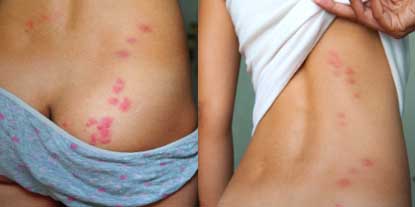 Bed Bug Bites on Buttocks
Bed Bug Bites on ButtocksDelayed Reactions to Bed Bug Bites
Bites may not be noticeable immediately and sometimes take up to a day or more to appear. This delayed reaction can make it difficult to associate the bites with their source. The variability in reactions, from large welts to small red dots, adds to the challenge of identifying bed bug bites.
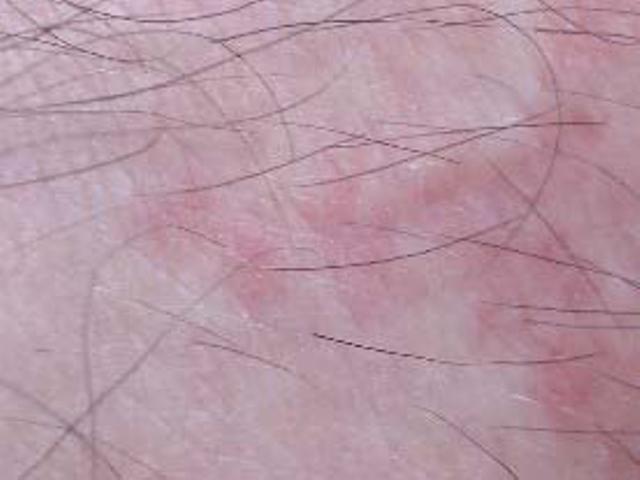 Bed Bug Bite After 30 Minutes
Bed Bug Bite After 30 Minutes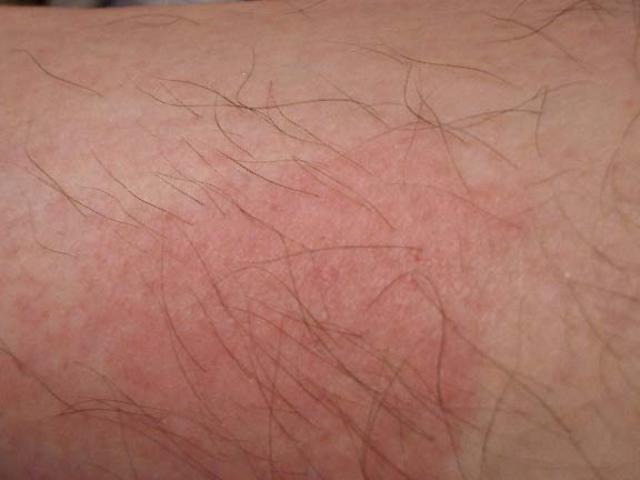 Bed Bug Bite Reaction after 48 Hours
Bed Bug Bite Reaction after 48 Hours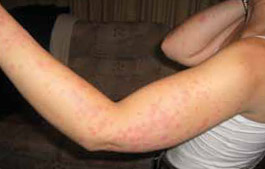 Bed Bug bites 4 days after Exposure to Bed Bugs
Bed Bug bites 4 days after Exposure to Bed BugsPsychological Impact of Bed Bug Bites
The uncertainty of having bed bugs causes significant stress and sleep disturbances for many people. The psychological impact of an infestation, or even the suspicion of one, can lead to anxiety and difficulty sleeping. Addressing these concerns promptly, either through professional inspections or effective treatment plans, can help mitigate this stress.
Importance of Professional Inspection
It can take weeks or even months before visible signs of bed bugs appear, even with ongoing bites. Many experts and users recommend getting a professional inspection if bed bugs are suspected. Professionals have the expertise to detect infestations that might not be visible to the untrained eye and can provide targeted solutions to eliminate the problem effectively.
Treating Bed Bug Bites
Treatment for bed bug bites typically involves alleviating itchiness and allowing the body to heal naturally. Most bites resolve within 1 to 2 weeks without intervention. Over-the-counter anti-itch creams, such as those containing hydrocortisone, can provide relief. Avoid scratching the bites to prevent secondary infections. If signs of infection, such as pus or increased redness, develop, seek medical attention promptly. Applying a cold compress or taking antihistamines may also help reduce swelling and itching. Bite marks that worsen over time should be evaluated by a healthcare professional. Effective ointments for bed bug bites include hydrocortisone cream and antihistamine gel, which can soothe irritation and reduce inflammation.
Dealing with a Bed Bug Infestation
A bed bug infestation can be a significant problem, requiring immediate attention to prevent its spread. Bed bugs thrive in sleeping areas, including mattresses, box springs, bed frames, and upholstered furniture. Signs of an infestation include shed skins, rusty-colored spots on bedding, and the presence of adult or young bed bugs. Early detection and intervention are critical to managing an infestation effectively. A pest control professional is highly recommended for identifying and eradicating bed bug infestations. Preventive measures such as sealing cracks, using protective mattress covers, and maintaining cleanliness can reduce the risk of recurrence.
First Signs of Bed Bugs
The first signs of a bed bug infestation often include small, itchy red welts on exposed skin, rusty-colored stains on bedding, and the discovery of shed skins or bed bug eggs near sleeping areas. Observing their feeding behavior and inspecting for a sweet, musty odor can also help confirm their presence.
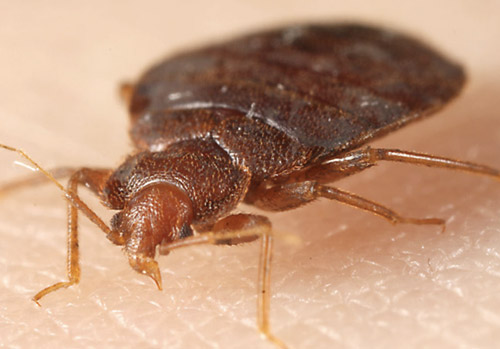
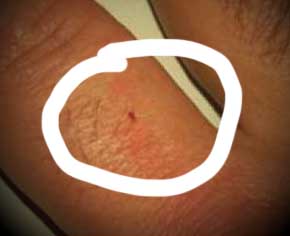 Bed Bug Feeding On Hand
Bed Bug Feeding On HandWhere Do Bed Bugs Hide?
Bed bugs commonly hide in cracks and crevices near their food source. This includes mattresses, box springs, bed frames, and upholstered furniture. They may also hide in electrical outlets, loose wallpaper, and even clothing stored near sleeping areas. Although bed bugs do not typically remain on the body after feeding, they may hide in folds of clothing or nearby personal items.
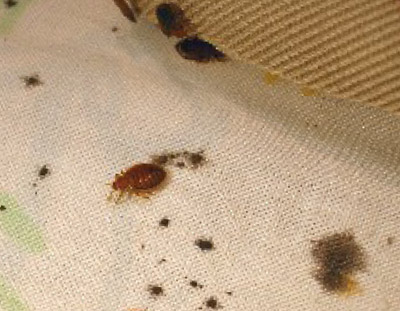 Mattress Stains Along the Seams and Black, Brown or Red Marks Near Tight Spaces Are a Sign You Have Bed Bugs.
Mattress Stains Along the Seams and Black, Brown or Red Marks Near Tight Spaces Are a Sign You Have Bed Bugs.Can You Feel Bed Bugs Crawling on You?
It is uncommon to feel bed bugs crawling on you because they are light and move slowly. However, some individuals may notice a slight tickling sensation if a bed bug moves across exposed skin.
Differentiating Between Bed Bug Bites and Other Insect Bites
Bed bug bites can look similar to bites from mites or spiders, but there are distinguishing characteristics. Bed bug bites often appear in clusters or a zigzag pattern, while spider bites are more likely to be isolated and may include a necrotic center. Mite bites are typically smaller and cause more diffuse itching. Careful inspection of your sleeping environment for signs of bed bugs, such as shed skins or rusty-colored stains, can help confirm the source.
There are several types of insects that cause bites that are similar to those caused by bed bugs:Other Causes of similar skin reactions
- Spiders
- Chiggers
- Scabies Mites
- Mosquitoes
Infectious causes:
- Fungal skin infection
- Chicken Pox
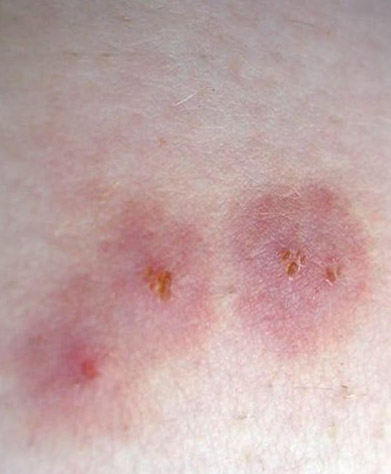 Spider Bites in a 3 dot Triangle Pattern
Spider Bites in a 3 dot Triangle Pattern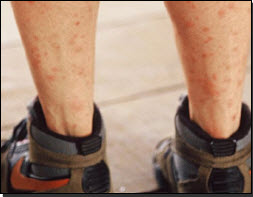 Mosquito bites on legs
Mosquito bites on legs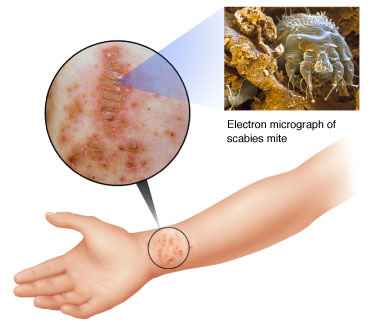 Scabies Skin Bites
Scabies Skin Bites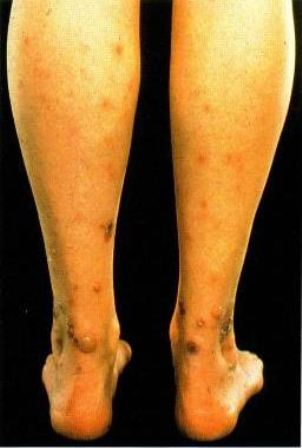 Flea Bites on Lower Legs
Flea Bites on Lower LegsBed Bugs in Clothing
To determine if bed bugs are in your clothes, inspect seams and folds for signs such as live bugs, bed bug eggs, or excrement. Washing clothes in hot water and drying them on high heat can eliminate bed bugs and their eggs. Storing clothes in sealed plastic bags can prevent further infestation.
What If There are No Signs of Bed Bugs?
If bites resemble bed bug bites but no signs of bed bugs are present in your home or apartment, consider other possible causes. Flea bites, mite bites, or allergic skin reactions could be responsible. Consulting a pest control professional or dermatologist can help determine the cause and provide appropriate treatment.
Preventing Bed Bug Bites
Preventing bed bug bites involves addressing and eliminating infestations. Carefully inspect sleeping environments, including mattresses, box springs, bed frames, and upholstered furniture, for signs of bed bugs. Look for hiding places such as electrical outlets, loose wallpaper, peeling paint, or cracks in walls. Use a stiff brush to dislodge bedbugs and vacuum thoroughly. Consider sealing cracks and crevices to eliminate potential nesting spots.
Protective covers for mattresses and box springs can help prevent infestations. When in bed avoid exposed skin areas. For example where socks and tuck ends of pajamas underneath. Bed bugs cannot bite through thick clothes and must have direct content with the skin to feed. Avoid thin fatrics for this reason or holes or tears.
Female bedbugs can lay hundreds of eggs, so early detection is crucial. When traveling, inspect hotel rooms, including bed sheets and surrounding areas, and keep luggage elevated to reduce the risk of bringing bed bugs home. Addressing bedbug infestations promptly is essential to minimize health risks and discomfort. Observing their feeding behavior can provide additional clues about their presence. A pest control professional can help safely and effectively manage bedbug infestations in your home.
Myths and Misconceptions
There are several myths surrounding bed bug bites. One common misconception is that bed bug infestations are a result of poor hygiene; however, bed bugs can infest any environment, regardless of cleanliness. Another myth is that bed bug bites can spread disease, but current evidence does not support this claim. Some also mistake skin conditions, such as eczema or hives, for bed bug bites, emphasizing the need to find bedbugs for accurate identification. Additionally, bed bug bites can sometimes be confused with other insect bites, further complicating diagnosis. Bite marks are not unique to bed bugs and may require careful inspection of the environment for confirmation. Checking for shed skins in the sleeping area can help verify an infestation.
When to Seek Medical Attention
While bed bug bites typically heal on their own, certain situations warrant medical attention. If you experience severe itching, blisters, signs of an allergic reaction, or if bites become infected, consult a healthcare professional for appropriate treatment. Difficulty breathing or other systemic reactions should prompt immediate emergency care.
Got Questions About Bed Bug Bites? We're Here to Help
Do you have a question or story about bug bites? Share it! We will do our best to answer your questions. Please share pictures if asking about bites.
Reader Bed Bug Bites Q&A: What You’ve Asked and What We Suggest
Click below to see reader questions and contributions and our suggestions...
Insect Bites Next to Ear. Are These Bed Bug Bites? 




I woke up and had this bites next to my ear. I searched and no bites look like this?... Its swollen and it goes all the way down to the side of my. Neck. …
Are These Bed Bug Bites? Here’s How to Identify Them 




I have no idea what is biting me. I went to the dermatologist and she said a spider, from what I am reading a spider does not have a distinct line like …
Are These Bed Bug Bites On My Leg 




I was just wondering if I have a bedbug bite. It appears to only be on my right leg, and in rows of 2. It has increased in number everyday. Is it a …
Can Your Landlord Demand Payment for Bed Bug Treatment? Know Your Rights Not rated yet
Reader Question: Who Pays for Bed Bug Treatment in a Rental? Can my landlord demand full payment for bedbug treatment when I'm low income and on Section …
Do Bed Bug Bites Have a Dark Puncture Mark? Let’s Investigate Not rated yet
Reader Question: Identifying Bites with Dark Marks Do bedbug bites have a tiny black/dark brown puncture mark, black dot or blackish brown small line …
What Is Causing Itchy Bumps on My Hands? Here's What You Should Know< Not rated yet
Reader Question: Itchy, Swollen Bumps on Hands I do not know why I have these bumps on my hands but they itch really bad. They do not spread but sometimes …
Do I Need a Professional for These Bites? Here's What to Consider Not rated yet
I have 4 bites on my wrist, see photo, and 3 bites on right hand. A few single bites on knee, and 1 on my back.
I live in Florida and have mosquitoes …
Bedbugs? Please no! Not rated yet
I lived in a retirement apartment building in 2012-13. We had a friend with an infestation, and had a friend give us a recliner that turned out to be infested. …
Dealing with Bed Bug Bites: A Reader's Experience and Key Insights Not rated yet
Reader Submission: A Personal Battle with Bed Bug Bites I am also a victim of Bed bug bites. I visited my doctor, showed her the worst three on my right …
Bed Bug Bites May Vary Not rated yet
Reactions and bite marks can be different from one person to the next! Some people don't show bed bug bites at all.. Others can have a terrible reaction! …
Can Sunlight Kill Bed Bugs in Your RV? Here’s What to Know Not rated yet
Reader Question: Will Leaving an RV in the Sun Eliminate Bed Bugs? We are on a cross country trip in our RV. I started noticing bites on my back about …
Are These Bites Still from Bed Bugs? Here's Our Thoughts Not rated yet
Reader Question: Are These Marks Still Caused by Bed Bugs? I have a friend bring bed bugs into my home a couple months ago and it's been hell but I've …
What’s Biting You? How to Solve the Mystery of Invisible Bites Not rated yet
Reader Question: Unseen Bites That Itch and Disappear I'm being bitten by something that I can not see some times it feels almost like a sting and then …
What’s Biting You? Thoughts on Persistent Bites and How to Solve the Mystery Not rated yet
Reader Question on Causes of Bites I have tiny bites all over the insides of my thighs and some one my bottom and legs. Mainly backs of legs and inner …
Should You Replace Your Bed if Bed Bugs Are Found in the Headboard? Here's What to Do Not rated yet
Reader Question: What to Do About Bed Bugs Found in the Headboard? We found bedbugs under buttons in our fabric bed board. What should we do? Do we need …
Dealing with Persistent Bed Bugs in an Apartment Complex: What You Can Do Not rated yet
Reader Question: Ongoing Bed Bug Problem Despite Spraying I have been having a problem with begbugs since moving to Canada 2 years ago.
My apartment …
Bug/spider bite Not rated yet
I'm not sure if mine is a bed bug bite, I'm almost certain it's some type of bug or spider bite. It's 6 dots in a circular pattern with one dot in the …
Calamine Lotion for Bed Bug Bites Not rated yet
I have gotten bed bugs and at first, the bites were like small mosquito bites. I bought two mattress kits, one for my mattress and one for my box spring. …
Clothing and Bed Bugs Not rated yet
Reader Question : If clothing is found and has bed bugs how long can they survive and how do you get rid of them?
Editor Response
Hi Roberto, …
Are These Bed Bug Bites or Something Else? Here’s What Might Be Happening Not rated yet
Reader Question: Are These Bites from Bed Bugs or Another Cause? I moved into an apartment in Sioux City. Within two weeks I was covered in bites that …
Can Bed Bugs Follow You Home From Infested Hotel Room? Not rated yet
I stayed at a hotel and got triangle bite marks. Will the bedbugs follow me to my house?
Editor Response - Bed Bug Issue in Hotel Room
Hi Sam, …
What to do With Unwanted Bed Bug Travelers Not rated yet
I am traveling from California to Florida and I am now in Jackson Ms. and I have bed bug bites. I will reach me destination tomorrow. What can I do to …
Itchy All Over but No Bite Marks? Here’s What Could Be Happening Not rated yet
Reader Question About Itching All Over I am extremely itchy all over my body, but I have no bed bug marks. I found some dead bed bugs, but no bite marks …
How Many Treatments Are Needed to Eliminate Bed Bugs From an Apartment? What to Know Not rated yet
I've been treated once a month for the past 3 months now they are going to do a 4th one. It has improved a little bit. But they don't really focus on other …
A Survivor’s Take: Lessons from Years of Bed Bug Battles Not rated yet
Learn From My Bed Bug Experience An absolute nightmare! Over the course of about 4years and 2 infestations in different locations Ive become somewhat …
Bug Bites in Triangle - What is the Cause Not rated yet
Soon after family left after visiting, I noticed a large traingle shape on my knee with three large bug bites. They do not look like bed bug bites (been …
Severe Reaction to Bed Bug Bites: Can It Affect Your Health Long-Term? Not rated yet
Reader Comment: Experiencing Severe Health Effects After Bed Bug Bites I was bitten over 300 times between the 12th and 15th of August. I have been ill …
Dealing with Bed Bug Infestations: Marty’s Story and Lessons Learned Not rated yet
Reader Question: Identifying and Addressing a Bed Bug Problem
My wife started complaining of mosquito bites one morning. This went on for about 2 weeks …
an Bed Bugs Get on Dogs and Cause Bites? Our Take On the Problem Not rated yet
After discovering these bites on my mom and checking her bed I found the little creatures, after way over a $100 worth of products, home remedies as well, …
Identifying and Eliminating the Pests Found in Your Daughter’s Bed Not rated yet
Reader Question: What Are These Bugs in My Daughter’s Bed? My daughter recently woke up to over 23 bites on her body... we found these in her bed.. what …
What Could Be Causing These Small Red Bites? Here's Our Take Not rated yet
Reader Question: Identifying Itchy Red Bites I have recently gotten a few small, itchy red bites on my left leg and one or two elsewhere on my body, but …
What’s Causing These Bites? Advice for a Concerned Parent Not rated yet
Reader Question: What’s Causing These 'Bites' on My 4-Year-Old? PLEASE HELP!!! I have a 4 year old that has had these 'bites' appear on her for the last …
Can Bed Bugs Be Brought into a House by a Dog? Not rated yet
My small dog is a house dog. He runs down to a wooded lot, where wildlife hides.
This infestation has been the worst of the 25 years I have lived in this …
What do bed bug bites look like on a baby Not rated yet
I keep seeing this on my son but only when I let him play on the carpet in the living room.
Response to Your Question
Hi, thank you for sharing …
Bad Bedbug Bite Reaction! Not rated yet
Moved into a house infested with bedbugs and did not have any bites at first! As we waited for the landlord to have the problem treated, I began to break …
Are These Bed Bug Bites - Image Review By Our Editor Not rated yet
My 8 yr old daughter is having some kind of bites/spots. She will have some plain red marks for a couple of days, and they will itch. These will go away/come …
What caused this bite? Not rated yet
Reader Question: Is this a bed bug bite? This is a bite on the upper arm of my 10 year old son...no clue what caused it.
Suggestion from our Editor …
Are there Documented Cases Where the Same Triangular Patch of Bedbug Bites Continued to Come and Go for a Year? Not rated yet
I have a triangular set of bumps on my left forearm at the crease of my elbow. They appear to be like the 1st photo labeled, mild case. What I don't understand …
What Is This Bite From? Not rated yet
My boyfriend is a truck driver and was sleeping in his truck last night like always and woke up with 2 bites on the back of each thigh up near the crease …
Source of Bed Bugs in a Group Home Not rated yet
I need some help. My son lives in a group home. Last week my son ended up with bed bug bites all over his body but no one else has them. my son is also …
Bed Bug Treatment for an Infested Chair Not rated yet
I brought a lovely recliner chair from a decent neighborhood. The first evening, while relaxing in white dressing gown, noticed movement of "brown rice …
Landlord/PCO/Bedbug Experience - How To Get Rid Of Them Not rated yet
I live in an old brick building in Canada with hardwood floors. I have refinished it to it's original condition with a modern touch. I expected to stay …
Bed Bugs Can Live On or Near a Latex Mattress Not rated yet
Can bed bugs live in a latex mattress? And can they cause bites in a line on your skin?
Response to Your Question Regarding Bed Bugs and Latex Mattresses …
Can Laundry Rooms Spread Bed Bugs? What to Know Not rated yet
Reader Question: Can Bed Bugs Spread Through Shared Laundry Rooms? When there are bed bugs in the apartment and the tenant uses the apartment laundry …
Given a Sofa Bed And Now Waking Up Covered in Bites? Here’s How to Regain Control Not rated yet
Reader Question: Can I Get This Under Control? When it comes to bugs the usual saying is there are 10x more than what can be seen. Is this true here too …
Bites,bedbugs etc. Not rated yet
I moved into this apt 3 years ago and experienced bites right away. I tried everything and finally it went away. Today 2 years later im being bitten again. …
Itchy Red Bumps on Your Stomach? Here's What Might Be Happening Not rated yet
Reader Question Regarding Itchy Red Bumps Spreading Throughout the Day: I have red bumps on my stomach and there really itch. I do not know what is causing …
Bed Bugs Need Blood At Every Stage Not rated yet
Do bedbugs need blood at every stage of lifecycle to grow to the next stage ? Can they grow without getting blood ?
Editor Response: Do Bed Bugs Need …
Why Do Bed Bugs Bite Me and Not Others? Here's Why You’re the Target Not rated yet
Reader Question: Why Do Bed Bugs Bite Me and Not My Girlfriend? Hello, Why is it that when I am trying to sleep the bed bugs bite me only and not my girlfriend. …
Do Bed Bug Bites Cause Hives? Not rated yet
I have four little bites that just appeared out of nowhere in my wrist and about 3 bitemarks on my back that are small, red and swollen, not even sure …
Are Bed Bites From Spiders, Earwigs or Bed Bugs Not rated yet
My wife had just washed all my linen and I put it on my bed. I sleep in the lower level of the house as I snore real bad. I'm on the 4th level, not the …
My Bed Bug Story Not rated yet
I am 15 and have always been loved by bugs sonce i was little. I recently painted my room, took apart my bed ect. I had put a mattress cover on my bed …
Can You Sue Your Landlord for Bed Bugs? What to Do Next Not rated yet
Reader Question: Can I Sue My Landlord for Not Removing Bed Bugs? I am wondering if i can sue my landlord for not removing the bedbugs in my duplex. I …
Struggling with Bed Bugs? Here’s How Heat and Other Methods Can Help Not rated yet
Reader Question: Can Heat Help Eliminate Bed Bugs? I have sprayed 5 times. Ive used borax, salt, garlic, thyme, cayenne pepper, vinegar and still have …
What Works to Eliminate Bed Bugs? Some Suggested Solutions Not rated yet
Ive sprayed 5 times. Ive used borax, salt, garlic, thyme, cayenne pepper, vinegar and still have these stupid bugs. were going to try to turn the heater …
Do Indian Clay and Apple Cider Vinegar Really Work for Bed Bug Bites? Here’s Our Thoughts Not rated yet
Reader Tip: Treating Bed Bug Bites with Indian Clay and Apple Cider Vinegar Treat your bites with an Indian clay and raw unfiltered apple cider vinegar …
What To Do If You Find Only One Bed Bug In Your Home Not rated yet
What should I do if I have found only one bed bug? We have had a firm to the house and they examined the bed and surrounding area and could not find anything? …
Are These Bed Bug Bites? Not rated yet
Question: Can someone plz tell me if these are bed bug bites?
Response to Michelle
Hi Michelle,
Thank you for sharing the image. I’ve reviewed …
Question about bed bug bites! Not rated yet
I have been breaking out into massive hives over the past month, and have noticed they are most severe in the morning when I wake up or (starting last …
How ti Investigate Hives and if They are Bed Bug Bites Not rated yet
I have been breaking out into massive hives over the past month, and have noticed they are most severe in the morning when I wake up or (starting last …
Suggestions for Preventing Indoor Insect Bites Not rated yet
My son woke up with bites similar to those of a mosquito. The bites are of no particular pattern. Some bitten areas are of head, neck, back, legs, & arms. …
Mystery Insect Bites Not rated yet
For the past 5 years I've gotten mysterious bites on my chest, thighs, and buttocks area during the night. My husband and I have checked and cleaned as …
Feels Like Worms on my Skin Not rated yet
I am in a work release program and while lying in the bed i feel as if theres something jumping on me. I can feel them on my arms, legs, face, and lips. …
Mystery Skin Bumps at Night? Possible Causes and Solutions! Not rated yet
I am freaking out idk what to do my daughters bed is so stained that I'm not sure if we have bed bugs or dust mites maybe she needs a new bed.
Anyways, …
References
- Mayo Clinic Staff. "Bedbugs - Symptoms and causes." Mayo Clinic, Jan. 5, 2024. (mayoclinic.org)
- Centers for Disease Control and Prevention. "About Bed Bugs." CDC, May 2, 2017. (cdc.gov)
- Healthline Editorial Team. "Bedbugs Bites: What They Look Like, Treatment, and More." Healthline, Aug. 22, 2024. (healthline.com)
- Verywell Health Editorial Team. "How to Treat Bedbug Bites: Effective Remedies and Prevention Tips." Verywell Health, Jul. 11, 2024. (verywellhealth.com)
- WebMD Editorial Team. "Bedbugs: How to Identify and Prevent an Infestation." WebMD, Jun. 15, 2023. (webmd.com)

